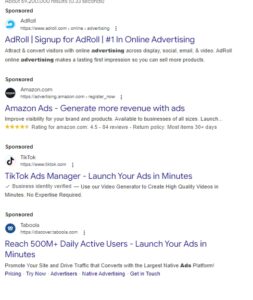
| Ad Type | What It Is | Best For | Pros | Cons |
| Display Ads | Website banners. | Brand awareness. | Visual, easy setup. | Often ignored. |
| Native Ads | Blends with content. | Natural engagement. | Less intrusive. | Can seem “sneaky.” |
| Search Ads | In search results. | High-intent clicks. | Great for conversions. | Can be pricey. |
| Social Ads | In social feeds. | Targeted reach. | Highly specific. | Feels intrusive. |
| Video Ads | Plays with videos. | Storytelling. | Highly engaging. | Can be skipped. |
What Is Ad Placement, and Why Should You Care?
Ad placement is about where your ads appear, whether on websites, search engines, social media, or other digital spaces. Good ad placement means your ads reach the right audience when they’re most likely to engage.
From display ads on websites to the search ads that pop up on Google, finding the perfect spot for your ads can boost your results significantly.
Different Types of Ad Placements
Display ads are those banners and boxes you spot on websites. They’re perfect for grabbing attention and making people aware of your brand.

Native ads are sneaky—they blend right in with the content of the site, so they don’t feel like ads at all. Search ads show up right at the top of search engine results, so they’re in your face when you’re looking for something specific. Social media ads pop up in your feeds or as sponsored posts, making the most of the time people spend on
Facebook or Instagram. And then there are video ads, which you often see on YouTube—whether they play before, during, or after a video, they’re usually pretty engaging.
Key Factors That Make or Break Your Ad Placements
Optimizing ad placement is more than picking a platform—it’s about tweaking all the little details to get the best results. Here are some of the big factors to consider:
- Knowing Your Audience: Start by getting to know your audience—where they hang out online and what content grabs their attention. Tools like Google Analytics and Facebook Insights can help you understand them better, making it easier to connect in their space.
- Picking the Right Ad Format: The design and format of your ads are huge. A flashy video might do wonders on Instagram, but a straightforward text ad could be more effective in search results. Tailoring your ad’s look to fit the platform and audience can make all the difference.
- Matching Ads with Content: Ever notice how some ads just feel like they belong on the page? That’s the magic of contextual relevance. When your ad aligns with the content around it, people are more likely to see it as helpful rather than annoying. This approach not only boosts engagement but also enhances your ad’s overall effectiveness.
- Considering Device Differences: People use all kinds of devices to browse—phones, tablets, desktops, you name it. What works on a desktop might not look so great on a smartphone. Make sure your ads are designed to be responsive, adjusting smoothly to different screen sizes and orientations.
Nailing Ad Placement: Tips and Tricks
Test, Test, Test
A/B testing, or trying out two versions of an ad, is a great way to see what works best. Change up placements, formats, or designs to find out which combination gets the best results. This kind of testing is key to refining your ad strategy over time.
Use Heatmaps to Your Advantage
Ever wonder where people click or hover the most on a webpage? Heatmaps can show you just that, highlighting the hotspots of user activity. This can help you pinpoint where your ads are most likely to get noticed.
Think Mobile First
More and more people are browsing on their phones, so optimizing your ads for mobile is crucial. This means making sure they load fast, look good, and fit naturally on smaller screens. Mobile optimization isn’t just a bonus anymore—it’s a must.
Go Programmatic with AI Tools
Programmatic advertising is all about using automated systems to purchase ad space, making it easier to place ads that are highly targeted and can adjust on the fly. With AI tools in the mix, they can quickly analyze tons of data to figure out which ad spots will likely give the best results, cutting down on the guesswork along the way.
Platform-Specific Ad Placement Strategies
- Google Ads: Search vs. Display: Google Ads gives you two main options: Search and Display. Search ads are all about text and keywords, showing up in search results for high-intent targeting. On the other hand, Display ads are more visual and can appear across a wide network of websites, making them perfect for retargeting and brand awareness.

Google paid ads - Social Media Savvy: Different social media platforms each have their own vibe, so your approach needs to match up. On Facebook and Instagram, you’ve got loads of options like feed ads, stories, and carousels, plus some seriously detailed targeting tools to really hone in on your audience. LinkedIn is the go-to for B2B marketing, with ads that blend smoothly into feeds, inboxes, or as sponsored posts. TikTok, on the other hand, thrives on quick, catchy videos that slip right into users’ daily scrolls.
- Video Ads on YouTube: YouTube is a powerhouse for video ads. Whether your ads are skippable or not, their placement—before, during, or after the video—can significantly affect their impact. Knowing your audience and choosing the right format can lead to higher engagement rates.
- Native Advertising: Native ads are designed to look like part of the surrounding content, making them less intrusive and more engaging. Platforms like Outbrain and Taboola excel in placing these types of ads within content recommendations.
Common Pitfalls to Watch Out For
- Overloading with Ads: While it might seem like more ads equal more clicks, overcrowding a page can lead to “banner blindness,” where users just start ignoring them. Balance is key—too many ads can turn visitors off.
- Missing the Target: Not hitting your audience right is like throwing darts blindfolded. Poorly targeted ads waste your budget and fail to resonate. Always refine your targeting parameters using data-driven insights.
- Ignoring the Numbers: If you’re not keeping tabs on your ads, you’re basically in the dark. Make sure to track things like click-through rates, bounce rates, and conversions to see what’s hitting the mark and what needs tweaking.
- Forgetting Mobile Users: Don’t underestimate the importance of mobile. With so many users browsing on their phones, ignoring mobile optimization is a costly mistake. Ads need to be quick-loading, well-designed, and easy to interact with on a mobile device.
Wrapping It Up
Ad placement optimization isn’t a one-and-done task—it’s an ongoing process of testing, tweaking, and refining. By staying on top of audience trends, leveraging the latest tools, and keeping your strategy flexible, you can maximize the effectiveness of your ad placements. It’s all about finding that sweet spot where your ads resonate most with your audience.
Key Takeaway: Optimizing ad placement is all about being strategic and responsive. Keep testing, keep analyzing, and don’t be afraid to switch things up based on what the data tells you. With the right approach, you can make sure your ads are not just seen but also engaged with—and that’s where the real value lies.
FAQs
How can I figure out the best ad placement for my business?
To find the best ad placement, start with understanding your audience’s behaviour. Use analytics tools to track performance and conduct A/B tests to see which placements get the best results.
What should I consider when choosing ad formats?
Think about where your audience is and what kind of content they engage with. For example, video ads might work well on YouTube, while native ads could be better for content-heavy sites.
How often should I revisit my ad placements?
It’s a good idea to check in on your ad placements at least once a month. Regular reviews help you catch any changes in performance early, so you can adjust before your budget takes a hit.
What are some signs that my ad placements aren’t working?
Low click-through rates, high bounce rates, or flat conversion numbers are clear signs that something’s off. If people aren’t engaging with your ads, it’s time to re-evaluate where they’re showing up.
Can I automate my ad placement optimization?
Yes, using programmatic advertising platforms and AI tools like AdRoll or Taboola can automate the process, adjusting your placements based on real-time performance data to get the best results.
